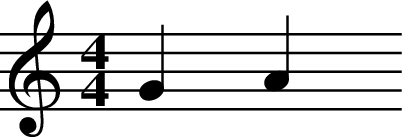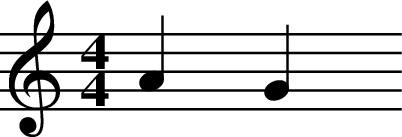Developing a kinestetic responce to pitch notation, sight reading on the ocarina
Sheet music represents several things at once. As we explored in the article The basics of learning to read rhythm notation by ear, the overall shape of the note symbols—head, stem and flags together—describes the duration of the notes.

And the pitch—which fingering to play on your instrument—is communicated by the position of the note head on a staff, 5 equally spaced lines:

The treble clef (the squiggly symbol at the left) tells you that the note G is on the second line from the bottom.

And placing a note's head in this position tells you to play the note 'G' on your instrument, which is fingered as follows on an alto C ocarina.
The logic behind sheet music is discussed in much more detail in the article Playing the ocarina with sheet music.
Notes can be placed either on the lines of the staff, or the spaces, and if we place a note one position higher than the G line, it tells us to move up by one note, lifting the left middle finger.

Likewise, if a note descends by one position, we need to place down one finger again.

Exercises to internalise notation reading on the ocarina
Learning how to read notation fluently is a matter of learning a few different things:
- First, you need to train muscle memory to be able to easily move between the notes you will be using—if you need to stop to think 'now which fingers do I need to move to change from note...to note..., you're going to be stalling all the time.
- Secondly, you need to learn how the visual patterns in notation relate to these patterns of muscle memory on the instrument.
Developing muscle memory
The first step here can be done by choosing the notes of one scale, starting on the first note in that scale, and then sequentially jumping from every note, to every other note. If we were to start with 3 notes of the C scale, 'G, A and B', you'd practice:
- G - A
- G - B
- G - ^C
Then repeat this same pattern starting from the middle note:
- A - G
- A - A
- A - B
- A - ^C
And finally for this sequence of notes, from the high C going down to every note below it.
- ^C - B
- ^C - A
- ^C - B
- ^C - ^C
Exhaustively practising note transitions in this way means that we can move around the notes on the instrument without needing to think about what fingers we need to move to do that.
Connecting notation to the muscle memories
Connecting the visual notation on the staff to the muscle memories on the instrument can be done by using intervals.
You already have the reference point of G, and so you need to look at the staff and see how many positions you need to move up or down by in the scale. Start on G, if the next note is one position higher, then you need to move up by one position on the staff.
Intervals don't change depending on which note you're starting on, a second is a second, and corresponds to the same transition on your ocarina.
Include the exercise here from the book I made for Sidmouth festival where there are exercises asking the student to identify a series of intervals.
Patterns using 2 notes
Have a go at reading this notation, which uses the rhythm patterns introduced in the basics of learning to read rhythm notation by ear
For each one:
- Make sure you can hear the sound of the rhythm, then try playing the notes.
- Remember to use the right breath pressure, so that the notes sound in tune.
- When you switch between notes, aim to change your fingering and breath pressure as fast as possible.
Exercise 1

Note that using a metronome can help to pace yourself. Practising at a slower tempo gives you more time to think, whereas faster tempo increases the difficulty.
Exercise 2

Exercise 3

Exercise 4

Exercise 5

Exercise 6

Exercise 7

Exercise 8

Exercise 9

Exercise 10

How did you find that, was it easy, or difficult? If you feel like you can read music of this complexity without thinking, feel free to move on, but if not, make some more exercises for yourself and keep practising.
After a few days, reading very simple notation using just two notes like this will be internalised, and you'll be able to do it without thinking.
Patterns using 3 notes
When notes move up in sequence, you continue to lift fingers, like this:

Thus, when notes move down, you place fingers.

Moving up or down by two positions thus corresponds to moving up or down by two steps in the instrument's scale:

And these positions can be internalised as before, by reading a lot of notation at this complexity level, until you can play such notation as soon as you see it.
Exercise 1

Exercise 2

Exercise 3

Exercise 4

Exercise 5

Exercise 6

Exercise 7

Exercise 8

Exercise 9

Exercise 10

And like before, keep working on exercises at this level until it gets easy.
What's next?
It's fine to continue to internalise pitch and rhythm reading by gradually increasing the range of notes you're using, as well as other rhythmic patterns, practising until reading it becomes automatic.
As you learn more notes, you'll start to be able to read some simple music on sight, but learning one note at a time, it could take a long time until you can read every note and every transition.
We can fast track that process because a lot of music is highly pattern based, and we can learn how to play those patterns directly. See reading melodic figures.
The article series 'Getting started playing the ocarina with sheet music' goes into the methodology, and more advanced concepts like keys and key signatures.